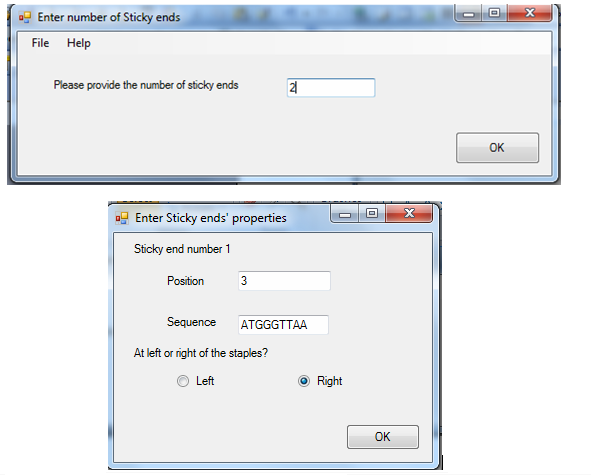DNAmazingResult: Difference between revisions
| Line 63: | Line 63: | ||
<div class="main" style="padding-top:10px; padding-bottom:10px"> | <div class="main" style="padding-top:10px; padding-bottom:10px"> | ||
=Overview= | =Overview= | ||
[[Image:Resultsum.png|500px|right]] | |||
Basically, during the summer we have successfully developed the following features for the first version of DNAmazing: | Basically, during the summer we have successfully developed the following features for the first version of DNAmazing: | ||
#"One-click" feature to get the results(Automatic generation of folding path, crossover positions, and staple sequence) | #"One-click" feature to get the results(Automatic generation of folding path, crossover positions, and staple sequence) | ||
| Line 69: | Line 69: | ||
# Bonus: Basic user-friendly interface | # Bonus: Basic user-friendly interface | ||
=="One-click" feature to get the results== | =="One-click" feature to get the results== | ||
The DNAmazing program successfully | The DNAmazing program successfully | ||
Revision as of 19:45, 2 November 2011
<html><head> <style type="text/css"> .main { margin: 0 auto; width: 804px;border-style:solid; border-width:5px; }
- logo{ margin:10px 0 0 52px; display:block; background:url('http://openwetware.org/images/7/74/Banner20.png') 0 0 no-repeat; width:700px; height:200px; text-indent:-9999px;}
.navbox { position: relative; float: left; }
- menu{ background:url('http://openwetware.org/images/3/3f/Menu_bg.png') 0 0 no-repeat; width:643px; height:100px; margin:51px 0 0 78px; padding-top:100px}
- menu li{ float:left;}
- menu a{ font-size:30px; color:#000000; line-height:1.2em; text-decoration:none; letter-spacing:-1px;}
.nav1{ padding:26px 0 0 37px;} .nav2{ padding:16px 0 0 30px;} .nav3{ padding:36px 0 0 17px;} .nav4{ padding:16px 0 0 19px;} .nav5{ padding:26px 0 0 30px;}
- menu .nav1 a:hover{ color:#bb0e0e}
- menu .nav2 a:hover{ color:#ca6509}
- menu .nav3 a:hover{ color:#3f9711}
- menu .nav4 a:hover{ color:#0ca0ce}
- menu .nav5 a:hover{ color:#8606c5}
</style> </head>
<div class="extra"> <div id="page_1"> <div class="main" style="padding-top:10px; padding-bottom:10px"> <!--header --> <header> <a href="index.html" id="logo">DNAmazing asfsaf. Smart. Effective</a> <nav> <ul id="menu"> <li class="nav1"><a href="http://openwetware.org/wiki/User:NUS_Dnamazing">Home</a></li> <li class="nav2"><a href="http://openwetware.org/wiki/DNAmazingMission">Mission</a></li> <li class="nav3"><a href="http://openwetware.org/wiki/DNAmazingProcess">Process</a></li> <li class="nav4"><a href="http://openwetware.org/wiki/DNAmazingResult">Results</a></li> <li class="nav5"><a href="http://openwetware.org/wiki/DNAmazingResources">Resources</a></li> </ul> </nav> </header> <!--header end-->
</div>
</div>
</div> </html>
Overview

Basically, during the summer we have successfully developed the following features for the first version of DNAmazing:
- "One-click" feature to get the results(Automatic generation of folding path, crossover positions, and staple sequence)
- Thermal stability calculation of sticky ends
- Bonus: Basic user-friendly interface
"One-click" feature to get the results
The DNAmazing program successfully
- Perform the automatic generation of possible scaffold folding paths from users' input and crossover positions for 2D DNA Origami structures
- Generate possible sticky end sequences
- Generate staple sequences with sticky ends which are necessary to conduct wet lab experiments for 2D DNA Origami structures.
With the "one-click" feature, the processing of DNA Origami design can be accelerated as users no longer have to do the raster filling (the folding path) manually which is definitely tedious for large and complex structure.
Automatic generation of possible folding paths and crossover positions
Generation of possible sticky end sequences
Generation of staple sequences
Bonus: Basic user-friendly interface
The User Interface (GUI)
GUI or graphic user interface is constructed to create a friendly environment for users to design their DNA origami. Our GUI is generated using Window form application in Visual studio 2010. Our software has three main tools to support the DNA Origami design with sticky end, to design, and to analyze the thermaldynamic properties of sticky ends.
Generate DNAO
For the first component, staples’ sequences used for the correct folding of DNA Origami with sticky ends are generated. User are required to define the size and shape of the structures they want to design by first input the frame size, and then choose the null squares (the location which will not be occupied by the scaffold). This would help the program to understand the DNA Origami design.
After obtaining the parameters required, the program will generate different possible scaffold ways and ask users to choose one of their interest.
Users can also choose to add sticky end by enter the number of sticky end they need and specify the sequence and location of sticky ends in the scaffold.
Final staple sequences are generated and appear in the result window.
Generate sticky end sequence
To support generation of sticky end, as well as, to ensure that the sticky end will not affect the scaffold folding, an additional component is provided. User can choose to manually input a DNA sequence, and the program can help to check for the most stabilizing binding position in the scaffold. The binding energy is also calculated for users’ reference.
User can also ask the program to generate the sticky end sequence with the defined length. DNA sequences with binding energy higher than a limit defined are given. The below image illustrates the output of sticky ends' sequence generation.
Thermaldynamic analysis
The other component of the software is also to support the sticky end analysis in which thermal dynamic values of the sequence are calculated. Users need to enter the sequence they want to analyze, together with the condition in which they would test the DNA (total DNA strand concentration, Na+ concentration, and melting temperatures). Thermaldynamics value including deltaG, deltaS, deltaH, and Tm are provided in the results pages.






